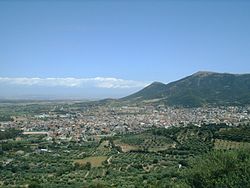Gonnosfanadiga
|
Gonnosfanadiga Gonnos |
||
|---|---|---|
| Comune | ||
| Comune di Gonnosfanadiga | ||
 |
||
|
||
| Coordinates: 39°30′N 08°40′E / 39.500°N 8.667°E | ||
| Country | Italy | |
| Region | Sardinia | |
| Province | South Sardinia | |
| Frazioni | Pardu Atzei | |
| Government | ||
| • Mayor | Fausto orrù | |
| Area | ||
| • Total | 125.23 km2 (48.35 sq mi) | |
| Elevation | 185 m (607 ft) | |
| Population (December 31, 2015) | ||
| • Total | 6,634 | |
| • Density | 53/km2 (140/sq mi) | |
| Demonym(s) | Gonnesi | |
| Time zone | CET (UTC+1) | |
| • Summer (DST) | CEST (UTC+2) | |
| Postal code | 09035 | |
| Dialing code | 070 | |
| Patron saint | Santa Barbara | |
| Saint day | December 4 | |
| Website | Official website | |
Gonnosfanadiga, Gonnos or Gonnos-Fanàdiga in Sardinian language, is a town and comune on the island of Sardinia, in the province of South Sardinia, Italy. It is located between Medio Campidano plain to the northeast and the Monte Linas massif to the southwest.
The economy is mostly based on agriculture (olives, olive oil, bread, sweets, pig meat) and animal husbandry. The territory is home to two giants' graves.
Its territory extends in similar proportions between the plain of Medio Campidano to the northeast, the hills around the town and the massif of Monte Linas to the southwest. It also includes a village in the territory of Guspini: Pardu Atzei (Sardinian: [aˈtsei]).
The plain type is volcanic-alluvial wetlands in the winter season, while the hills and mountains, rich in mineral deposits, have a variable composition with a predominance of granite, schist, and generally with a high rate of rock and limited depth of active layer; the highest point is Punta de sa Perda Mesa at 1,236 metres (4,055 ft).
The town is situated on the slopes of the mountains and is crossed by the Rio Piras, river with torrential character.
The area results to be inhabited since prehistoric times, studies date back to the early Neolithic attend certain, that occurred between the sixth and fourth millennium BC in the territory of the Terr'e Seddari, but can not be ruled earlier settlements resulting from the good position and wealth of resources.
There are also relevant evidence that include remains of the nuragic period, Nuraghes and giants' graves, one of which, that of S. Cosimo (brought to light by excavations in the early 1980s), is among the largest in Sardinia.
There is no certain claims of the Phoenician, but the area is both close to the sea, from which came the skilled sailors in the Middle East, both at Nabui (S. Maria Neapolis in the territory of Guspini) where they founded a colony, and other areas frequented by the Phoenicians certainly like Antas in the territory of Fluminimaggiore.
...
Wikipedia


